
The Museu Nacional d'Art de Catalunya, abbreviated as MNAC, is a museum of Catalan visual art located in Barcelona, Catalonia, Spain. Situated on Montjuïc hill at the end of Avinguda de la Reina Maria Cristina, near Pl Espanya, the museum is especially notable for its outstanding collection of romanesque church paintings, and for Catalan art and design from the late 19th and early 20th centuries, including modernisme and noucentisme. The museum is housed in the Palau Nacional, a huge, Italian-style building dating to 1929. The Palau Nacional, which has housed the Museu d'Art de Catalunya since 1934, was declared a national museum in 1990 under the Museums Law passed by the Catalan Government. That same year, a thorough renovation process was launched to refurbish the site, based on plans drawn up by the architects Gae Aulenti and Enric Steegmann, who were later joined in the undertaking by Josep Benedito. The Oval Hall was reopened in 1992 on the occasion of the Olympic Games, and the various collections were installed and opened over the period from 1995 to 2004. The Museu Nacional d'Art de Catalunya was officially inaugurated on 16 December 2004. It is one of the largest museums in Spain.

Lluís Borrassà was a Catalan painter. He was employed by the Crown of Aragon and is widely considered to have introduced the International Gothic painting style into the Principality of Catalonia.

Bartolomé Bermejo was a Spanish painter who adopted Flemish painting techniques and conventions. Born in Cordoba, he is known for his work in the Crown of Aragon, including the Principality of Catalonia and the Kingdom of Valencia. His real name was Bartolomé de Cárdenas: the name Bermejo, which means auburn in Spanish, possibly relates to his hair colour. Bermejo may relate also to his name, Cardenas; Cardeno means purplish.

Jaume Huguet was a Catalan painter.

The Altar frontal from La Seu d'Urgell or of The Apostles is a Romanesque altar frontal currently exhibited at the National Art Museum of Catalonia, Barcelona. The work dates from the second quarter of the 12th century and comes from a church of the Bishop of La Seu d'Urgell and was acquired in 1905. It is one of the masterpieces of the collection of panel painting of the MNAC. The frontal, the item covering the front of the altar, stands out for the quality of its bright colours and because it illustrates some of the characteristics of composition in Romanesque art, such as bilateral symmetry, abstraction of the background, with no reference to space or context, and the unnatural geometrical treatment of form to be observed in the folds of the clothing. It also shows certain conventions of representation, such as so-called hierarchical perspective, which consists in representing the chief character in a larger size.

The Altar frontal from Avià is a rare Romanesque altar frontal exhibited at the National Art Museum of Catalonia in Barcelona. It is the front of the altar of the church of St. Mary of Avià, in the county of Berguedà, later moved to MNAC Barcelona, while the church has a replica in place. It is dated to the 13th century or earlier, and was painted by an unknown artist.

The Saint Augustine Altarpiece is a Catalan Gothic painting in egg tempera by Jaume Huguet and Pau Vergós made between 1462 and 1475. The long duration of the work was caused by financial reasons, and it is assumed that work was begun by Huguet and finished by other members of his workshop, in particular Pau Vergós. The altarpiece was commissioned by the guild of tanners to be placed on the altar of the Augustinian friary of Sant Agustí Vell in Barcelona, Spain. The panel measures 250 × 193 × 9.5 cm and has been in the Museu Nacional d'Art de Catalunya (MNAC) in Barcelona since 1927.

The Apse of Santa María d'Àneu is a romanesque apse of the church of Santa Maria, Àneu, created in the late 11th century or early 12th century, the transferred frescos from which are now exhibited at Museu Nacional d'Art de Catalunya, in Barcelona. The decoration of the apse of the church of Santa María d’Àneu combines themes and motifs from the Old and New Testaments. Originally painted at the Church of Santa María d’Àneu

Saint Agnes is an oil-on-canvas painting executed c. 1635–1640 by the Italian Baroque painter Massimo Stanzione. It is now in the National Art Museum of Catalonia.

Erill la Vall Descent from the Cross is a set of seven 12th-century wooden sculptures from the Pyrenees village of Erill la Vall in Catalonia. Originally painted, it comprises a complete Romanesque Descent from the Cross sculpture group, which in Catalonia has the peculiarity that it is made up of seven figures. Two of the carvings are kept at the National Art Museum of Catalonia (MNAC) and the rest at the Vic Episcopal Museum.

The Mural paintings of the Conquest of Majorca is a group of Gothic paintings, created on 1285-1290, conserved at the National Art Museum of Catalonia, in Barcelona, Spain.
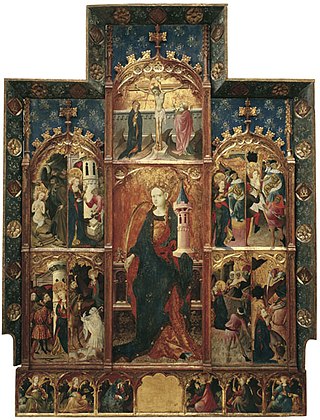
The Altarpiece of Saint Barbara is a painting by Gonzalo Pérez in the Museu Nacional d'Art de Catalunya in Barcelona.
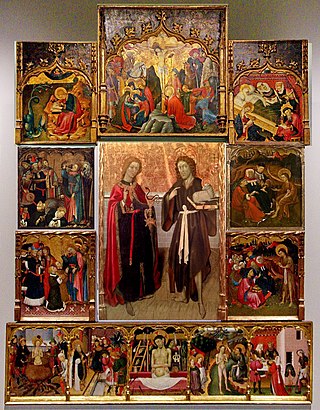
The Altarpiece of the Saints John is a painting by Bernat Martorell conserved at the National Art Museum of Catalonia.
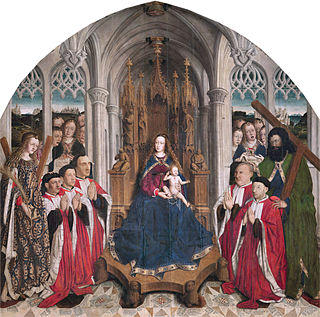
The Virgin of the Councillors is a panel painting in oils by Lluís Dalmau now in the National Art Museum of Catalonia in Barcelona. It was commissioned in 1443.
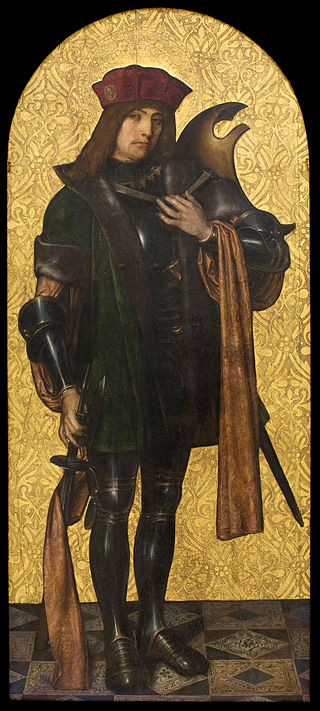
Saint Candidus is a painting by Ayne Bru, conserved at the National Art Museum of Catalonia.

The Gothic altarpiece of Santes Creus is an altarpiece painted by Guerau Gener and Lluís Borrassà between 1407 and 1411. It is one of the key works of the International Gothic altarpieces in Catalonia, created for the Santes Creus Monastery. The MNAC museum retains the Nativity, crowned by the figure of St. John the Evangelist, and the Resurrection of Christ, while the rest of the tables are kept in one of the chapels of the cathedral of Tarragona. The altarpiece was commissioned to Pere Serra but apparently died without starting it. Guerau Gener, a connoisseur of València international Gothic, replaced him, but his untimely death made Lluís Borrassà, one of the major figures in the painting of the first international Catalan Gothic, to complete the project.

The Altar frontal from Tavèrnoles is Romanesque altar frontal exhibited at the National Art Museum of Catalonia in Barcelona.
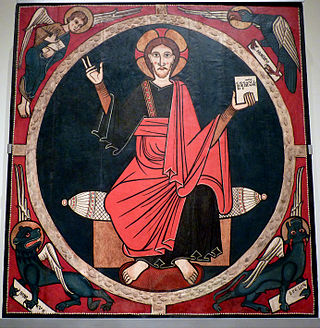
The Baldachin from Tost is a painted baldachin exhibited at the National Art Museum of Catalonia in Barcelona.
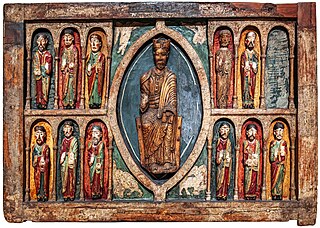
The Altar frontal from Santa Maria in Taüll is an altar frontal exhibited at the National Art Museum of Catalonia in Barcelona.
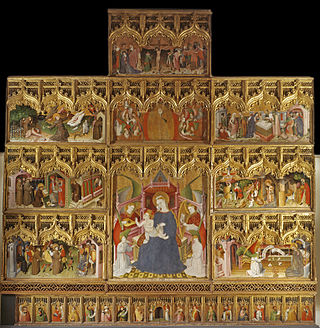
Juan Rexach, was a Spanish painter and miniaturist. His date of birth is not known.


























